What’s the goal of every freight carrier contract negotiation? Of course, it’s to sign cost-effective agreements that account for your current and future shipping needs. Yet it’s just as important to think about broad market conditions.
Data from your internal operations, carrier performance, and network performance should inform your negotiations. However, getting access to high-quality insights can be difficult if you don’t have the right system. If you’re like most shippers, you don’t have any time to waste.
Legacy transportation systems are notoriously error-prone because they rely on manual data entry and analysis. It’s hard to negotiate the best freight rates and save money when you have inaccurate and/or outdated data.
So here’s the question: How can you get valuable network insights to help lower your freight costs?
First, let’s lay some groundwork for what negotiations with freight carriers often look like and what makes them so challenging.
What are freight contract negotiations?
A freight shipping agreement lays out the terms of the relationship between you (the shipper or 3PL) and a carrier. Standard contracts cover details like distance traveled, weight of cargo, density, freight class, and any case-by-case accessorial charges.
However, freight contracts are penciled-in agreements – they’re tentative. Execution may vary depending on service lane availability, shipper demand, and carrier performance.
Plus, while carriers usually increase rates annually, renegotiations are on the table if your freight needs change. For this reason, contract management is an ongoing process.
What’s the first step to success? Pinpointing the top cost drivers within your transportation process. This is ironically also one of the many common obstacles shippers face.
What are the biggest challenges when negotiating freight contracts?
You’ll rarely be able to account for every factor that lands on the negotiating table, but you can prepare for these potential challenges:
- Lack of centralized and standardized data: If you can’t access your freight data baselines, you can’t understand your network needs or where your money is going. Intelligent logistics technology standardizes all of your network spend so you can improve your cost management.
- Inability to forecast near-future needs accurately: Anticipating changes to your shipping demand is important. Otherwise, you can’t project future freight needs and shipping costs. A comprehensive data set allows you to analyze trends and prepare for shifts like seasonal spikes.
- Difficulty managing risk proactively: Building relationships with multiple carriers will help you get an understanding of market rates. If negotiations with one carrier don’t go well, then you can turn to another contracted carrier or spot rates.
- Hard-to-track impact of discounts: Not all freight rate discounts save you as much money as you might think. You might get a 50% discount on shipments going from Zone 1 to Zone 4, which sounds good. But if 80% of your shipments are Zone 1 to Zone 3, then this discount won’t really impact your bottom line.
Did you catch the common thread across several of these challenges? Scoring cost-effective freight contracts depends on how well you understand your current network operations and forecasts.
5 ways to secure optimal cost and service in your freight contract negotiations
1. Know your operating model
Your operating model includes every aspect of how a load gets from its pickup location to its destination. So, you need full visibility into your network to know if a carrier agreement is cost-effective (and to negotiate the best deal if not).
Consider these factors to get a big-picture view of your operating model:
- Organizational framework: The behind-the-scenes processes and departments that make up your network operations, including customer service, logistics, and sales
- Network structure: The carriers, routes, transportation modes, distribution channels, and facilities you use
- Technology: Your transportation management system, warehousing management system, and any other tech in your tool stack
- Performance metrics: Carrier, route, and lane performance information
The challenge? Getting reliable, timely insight into these network factors.
In turn, you can spot high-cost lanes, routes, or accessorials to help you negotiate a lower rate. We recommend using freight analytics software to gather shipping data and performance information. These tools are faster and more accurate than manual efforts.
2. Know your shipping needs
You need to know your freight needs like the back of your hand. After all, they should inform how your network operates.
Start by creating a plan based on your current network requirements. Then, compare how you perform against that baseline each month. Use your findings to make adjustments.
For example, say your shipping volumes and routes change. You might need to consider opening a new facility or collaborating with a third-party logistics provider (3PL).
If they don’t change, consistency could be an incentive for another carrier to offer you better rates. Especially if you can reliably offer a high volume of shipments.
As a rule of thumb, enter contract negotiations knowing your forecasted demand for the next 12 months. This will keep you from getting locked into contract terms that work for you now but become less cost-effective as your needs evolve.
Pro tip: Build a list of “must-have” and “nice-to-have” contract terms after analyzing your freight needs and operations. It’s likely that not everything you want will make it into the finalized agreement. Your must-haves should be your biggest cost-saving opportunities.
3. Understand current market conditions
Current market conditions – including demand fluctuations, economic shifts, and more – directly inform how freight carriers structure their pricing. Fuel prices are another major factor, so it’s worth checking the U.S. Energy Information Administration’s national and regional averages regularly.
In any case, keeping tabs on market conditions helps you evaluate whether proposed contract rates and discounts are reasonable.
While keeping freight costs low is important, remember that carriers need to profit too. A successful freight contract negotiation should help you reach a mutually beneficial agreement – one with payment terms that align with carrier service levels.
Pro tip: Working with a publicly traded customer? Read their annual reports to see how they address market conditions and business goals. This can help you anticipate how pricing changes and prepare accordingly.
4. Establish your routing guide to improve internal decisions
As we know, freight contracts aren’t set in stone. A carrier may suddenly file for bankruptcy, or a broken-down truck may not be able to pick up your shipment. Both scenarios pose a risk to you.
However, you can never account for every potential supply chain disruption. This is why you need a routing guide or shipping guide to help your team make the right decision.
Establish a pecking order for choosing a carrier based on shipping rates, service levels, or a combination of factors for a given lane and mode. Include a backup option, as well as rules for accepting spot rates when a contracted carrier isn’t available at the agreed-upon price.
Having the option to change carriers without disrupting your network protects you. Yet it could also be the leverage you need during the negotiation process. If maintaining a good working relationship is a priority for you and your current carriers, this talking point can help you agree on fair contract rates.
5. Monitor financial and insurance risks
External factors aren’t the only sources of risk. For instance, losing a pallet mid-shipment is a disruption specific to your network. But it’s no less of a headache than something out of your control like an inclement weather delay.
Being proactive softens the blow when issues come up. Do the following to monitor financial and insurance risks:
- Assume a 10% to 15% overrun in your transportation budget: This creates a financial cushion for delays your forecasting can’t predict. As a result, disruptions like an unforeseen drought slowing the movement of goods through the Panama Canal won’t impact you as severely.
- Review and revise your forecast every month: Look at how your expected freight needs compare to market conditions and any disruptive events that may be on the horizon. Adjust your forecast monthly based on these findings so you’re ready to negotiate rates if necessary.
- For retail and consumer industries, pay attention to launch and promo dates: Many products have to be available across markets simultaneously to meet online and in-store demand. To plan for these milestones, you need total access to your data and streamlined operations.
Identifying your network’s biggest risk factors, performing ongoing analysis of important metrics, and devising backup plans are the first steps to reducing risk.
Get the insights you need for successful freight contract negotiations
The negotiation process is complex and ongoing. Yet accurate data-driven insights are valuable when reviewing your current operations. With such data, you can easily identify key cost-saving opportunities.
Loop automatically audits freight invoices and aggregates the data. Use these insights to inform big decisions like choosing new carriers and negotiating new contracts with your current ones. Get in touch with us today for more on how to gain greater control over your contract negotiations.










